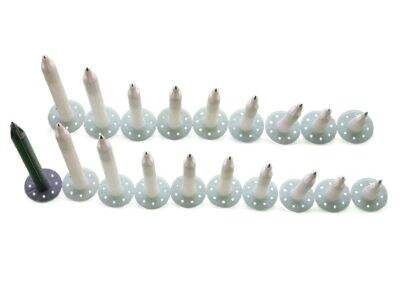If you are working on a project that requires insulation, you may be experiencing difficulty figuring out what insulation anchor to use. There are many different types of insulation anchors, and it can be difficult to determine which ones will work well for your particular project. We will guide you through different types of insulation anchors, things to keep in mind when choosing insulation fasteners, and how to find the right anchor for your insulation.
Let’s Take a Deeper Look at Insulation Anchors
First, a closer look at the types of insulation anchors you can choose from. There are four common types of insulation anchors which serve different purposes:
Self-tapping screws: Self-tapping screws are perfect for regard insulation to wood, metal, and other materials. Masonry insulation fasteners are working by drilling into the material, which secure the hold for masonry insulation. It is especially useful when you require a firm grip.
Drive anchors: These are generally compounded of plastic and need to slide into a pre-drilled hole. Masonry and concrete: For drivable materials, drive anchors are a good choice. They slot nicely into the holes you make, so pretty reliable.
Expansion anchors: These anchors may require a hole to be drilled into the material but they have a unique feature. The anchor plastic expands when the screw is inserted, so it tightly grips to the material. That’s what makes expansion anchors great for surfacing like brick, concrete, and masonry.
Adhesive anchors: These anchors bond through a high-tight adhesive or glue. They're highly versatile, and can actually be applied on various surfaces like concrete, wood, and masonry. And adhesive anchors are generally easy to install, available for many different types of projects.
Considerations for Selecting Insulation Anchors
We have learned the various types of insulation anchors now let us discuss the important things to look for before you choose one. Here are the primary factors you can rely on in making the proper selection:
Material: The first thing to give consideration to is the material you are applying the insulation to. This is very important! Such as if we put the insulation on the concrete wall, so we will need an anchor that can bear the weight of the insulation. Therefore, it is a good idea to use an expansion anchor so that it is powerful enough to hold the insulation."
Type of Insulation — The type of insulation selected will also play a role in your insulation anchor selection. Various types of insulation require different types of anchors. Some thermal insulation, for example, is soft and requires an anchor insulation with a larger head to properly cover the surface area. That helps the insulation stay put better.
Use of the Project: Finally, consider the purpose of the insulation. If you expect there will be movement, vibrations, or changes in temperature, you might need an anchor with more holding power or more flexibility. It is to keep the insulation secure at any cost.
Insulation Anchors: Part Number by Insulation Material
Having discussed the factors to consider while choosing an insulation anchor, let’s see how to pair the anchors with your insulation format. Doing so will ensure that you’re using the proper anchors for the job:
Installing Fiberglass Insulation: You can use either adhesive anchors or self-tapping screws for fiberglass insulation. In the case of concrete walls, the most suitable anchors will be expansion anchors, which allow for a secure anchor for this type of insulation.
Foam Insulation: Use adhesive anchors, drive anchors, or self-tapping screws for foam insulation. In the case your masonry wall gets foam insulation (the only one to keep drafts, in all casings) you want to take an expansion anchor so it fits on the wall.
Mineral Wool Insulation: To attach mineral wool insulation you use either expansion anchors or self-tapping screws. These expansion anchor plastic feature a strong design, making them ideal for retrofit applications.
Why you NEED to put in Insulation Anchors correctly
However、 Medical equipment is locked by the invasive surgery、 The process of developing power, having anesthesia、 Stay in the hospital after surgery. The installation method can have a major impact on the efficacy of the anchor and on the longevity of the insulation. Here are tips and steps you can follow to ensure proper installation:
Drill holes: Make certain that your drill holes are the right size for your anchor. This is very important since it locks the anchor correctly and prevents the connection from becoming loose. So, a good fit will keep everything in place.
Insert your Anchors: The next thing you need to do are insert your anchor into the hole (once you have drilled them of course) until they are flush with the surface. That means that the anchor has to be flush with the surface, so it doesn't interfere with a smooth finish.
Screws: We will tighten the screws to hold the insulation into the wall. Ensure you carry this out carefully so that it is all tightly held intact. If you properly secure the installation, this will allow the insulating material to do a better job over time.
Selecting Economical Insulation Anchors
With learning on how to select the correct insulation anchor and how to install it right, the next thing is about cost. This is critical for many projects as many must stick to a budget. So, here are some cheap insulation fasteners you may be interested in.
Self tapping screws: These screws are very cheap and versatile. This makes them popular among many projects as they can be used in a lot of different applications.
Drive anchors: Drive anchors are a low-cost option, particularly if you are dealing with concrete or masonry surfaces. Just note that these need to be pre-drilled so be mindful of this when estimating how long the install will take.
Adhesive anchors: Pricing and ease of installation rate adhesive anchors as one of the most economical methods available. They need a clean surface to adhere to, so be sure to have a clean surface before you install them.
 EN
EN
 AR
AR
 BG
BG
 HR
HR
 CS
CS
 DA
DA
 NL
NL
 FI
FI
 FR
FR
 DE
DE
 EL
EL
 HI
HI
 IT
IT
 JA
JA
 KO
KO
 NO
NO
 PL
PL
 PT
PT
 RO
RO
 RU
RU
 ES
ES
 SV
SV
 TL
TL
 IW
IW
 ID
ID
 SR
SR
 UK
UK
 VI
VI
 HU
HU
 TH
TH
 TR
TR
 FA
FA
 MS
MS
 GA
GA
 IS
IS
 LA
LA
 MN
MN
 NE
NE
 KK
KK
 UZ
UZ



